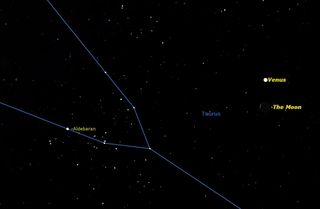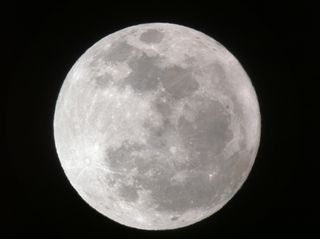
It should be worth any skywatcher's while to set an alarm for 60 to 90 minutes before sunrise tomorrow (June 24) to see a very pretty celestial scene.
If weather permits, look low toward the east-northeast horizon for a view of a very thin waning crescent moon, just three days before new phase. Situated about 3 degrees above and to the left of this slender lunar sliver will be the dazzling planet Venus. (Your fist held at arm's length measures about 10 degrees.)
And if you have binoculars and look early enough while the sky is still relatively dark, scan about 10 degrees above Venus for a view of the famous Pleiades star cluster, now just beginning to emerge back into view after being hidden in the glare of the sun for the past month.
Venus currently rises about 5 to 10 minutes after the first light of dawn. In the coming weeks, as the planet follows the sun through the northernmost part of the ecliptic and across the constellations of Taurus and Gemini, it will actually appear to rise at — or even just a little before — the break of dawn.
The planet will continue to rise in that fashion from July 10 through Aug. 4, roughly two hours before sunrise. By mid-August, however, Venus will be rising only about 90 minutes before sunrise and will rapidly sink lower into the bright morning twilight with each passing morning. Venus will be all but gone from the morning sky by the end of September.
So, in spite of the ungodly hour, get up early Tuesday morning and catch a view of Venus while it is still readily visible. As it rendezvous with Earth's nearest planetary neighbor, the moon will create a lovely celestial tableau to greet you on an early summer morning.

Editor's Note: If you have an amazing photo of the Venus conjunction with the moon that you'd like to share for a possible story or image gallery, please contact managing editor Tariq Malik at spacephotos@space.com.
Get the Space.com Newsletter
Breaking space news, the latest updates on rocket launches, skywatching events and more!
Joe Rao serves as an instructor and guest lecturer at New York's Hayden Planetarium. He writes about astronomy for Natural History magazine, the Farmer's Almanac and other publications, and he is also an on-camera meteorologist for News 12 Westchester, New York.Follow us @Spacedotcom, Facebook and Google+. Original article on Space.com.
Join our Space Forums to keep talking space on the latest missions, night sky and more! And if you have a news tip, correction or comment, let us know at: community@space.com.

Joe Rao is Space.com's skywatching columnist, as well as a veteran meteorologist and eclipse chaser who also serves as an instructor and guest lecturer at New York's Hayden Planetarium. He writes about astronomy for Natural History magazine, the Farmers' Almanac and other publications. Joe is an 8-time Emmy-nominated meteorologist who served the Putnam Valley region of New York for over 21 years. You can find him on Twitter and YouTube tracking lunar and solar eclipses, meteor showers and more. To find out Joe's latest project, visit him on Twitter.
